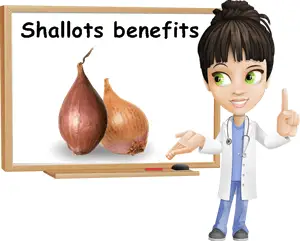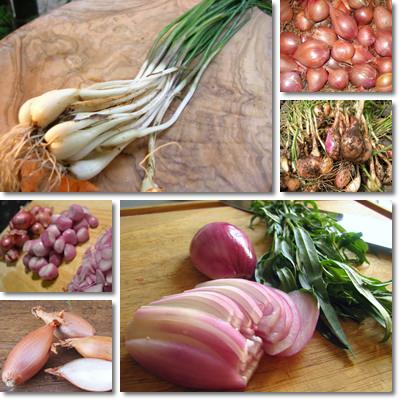A thinner, slightly more elongated type of onion, the shallot (Allium ascalonicum) is a good source of vitamins A, C and B6 and boasts a higher dietary mineral content compared to its relative, the average onion. Being a member of the Allium cepa species, the vegetable displays specific characteristics. For instance, regular consumption of shallots has impressive anti-mutagenic properties as well as cholesterol, blood pressure and blood glucose-lowering effects.
Shallots vs onions: difference
What are shallots and how are they different from regular onions? I am fairly certain many of us have wondered, at one point in our lives, what is all this fuss with shallots. After all, they’re onions. To be fair, shallots are a type of onion, but differ themselves from their relative in terms of appearance, taste as well as nutritional and antioxidant profile.
They are sometimes easily confused with garlic while in the ground due to the fact that they both grow in clusters and have thin, green, pungent stems. Just the same, their bulbs can be confused with regular onions due to looking pretty much the same. However, shallots are considered superior to regular onions as far as taste and nutrient profile are concerned.

What do shallots look like?
Shallots grow in clusters like garlic. They have long, thin, green tops with bulbs slightly smaller and more elongated than mature onion bulbs. Their elongated, sometimes pointy shape is more or less pronounced depending on the variety. Skin color may range from golden brown or copper to rose red or gray while the white flesh is sometimes tinged with magenta. However, most shallot varieties have a coppery skin. The bulb and the green tops are both edible, but the copper, papery outer skins should be discarded before use.
What do shallots taste like?
Uncooked shallots have a more savory, but mild and slightly sweeter flavor compared to regular onions which have a harsher, more pungent taste and smell. The difference in flavor is the reason why it is recommended to use two to three times the amount of shallots if you are substituting regular onions in a recipe. Cooked shallots have a milder, somewhat sweeter taste than regular onions and maybe a fading hint of garlic.
They are also milder tasting than red onions (see benefits of red onions).
If onions make you sick to the stomach, you can easily substitute them for shallots, but remember they are still onions and will have similar flavor-giving compounds which could elicit the same side effects, especially if eaten in large amounts, either raw or cooked. If you are altogether intolerant to onions, it might be best to not eat them at all. Slow cooking usually makes shallots as well as their relatives easier on the stomach, but this is not always the case.
If you have gastritis or acid reflux, avoid pungent foods like onions, garlic or leek (find out more foods to eat and to avoid for acid reflux).

What are the benefits of shallots?
Find out below what are the 6 most impressive nutrition facts and health benefits of shallots:
Richer in nutrients than onions
More exactly, shallots have significantly more folate, pyridoxine, vitamins A and C, phosphorus, manganese, copper, iron and potassium compared to regular onions. As a result, eating them on a regular basis can improve one’s nutrient intake as well as general state of health. For instance, shallots provide 35% of the RDA of vitamin A per 100 g. Vitamin A is known to help maintain good eyesight and support immunity.
Antibacterial, antifungal, antiviral
Shallots boast excellent antibacterial, antifungal and antiviral properties. Like the Alliaceae genus members, shallots contain an organosulfur called allicin that is released when they are either chopped, grated or crushed. Allicin was shown to possess antibacterial, antiviral and antifungal properties to which it owes its immuno-protective effects.
Highly protective of cardiovascular health
Allicin, the organosulfur compound in shallots, is responsible for the benefits of shallot on cardiovascular health. More exactly, allicin inhibits the formation of platelet clots in blood vessels, reducing overall coronary heart disease, peripheral vascular disease and stroke risks. In addition to this, it reduces blood vessel rigidity and blood pressure by causing the release of nitric oxide, a potent natural vasodilator.
Cholesterol-lowering effects
According to research in the field, allicin inhibits the HMG-CoA reductase enzyme in liver cells and thus helps lower cholesterol levels. However, allicin is only produced at the moment of crushing, cutting, etc. which means that shallots (and garlic) should be eaten raw, provided of course you are not intolerant or sensitive to them. Soon after, allicin in converted into other less effective active compounds.
Excellent blood sugar-lowering effects
Allicin, the biologically active compound in shallots, has been shown to normalize blood sugar (glucose) levels. For this reason, eating shallots and especially garlic is said to help prevent and contribute to the management of pre-diabetes as well as diabetes.
Great source of antioxidants
Shallots have been found to be a rich source of polyphenols and flavonoids with excellent antioxidant activity such as quercetin, kaempferol and sulfur compounds such as diallyl disulfide, diallyl trisulfide, allyl and allicin. Antioxidants protect against oxidative stress and damage to cells and DNA that can lead to mutations and cancer.
Conclusion
Shallots are now available year round and relatively affordable. Seen they are slightly more nutritious than regular onions in certain respects and less pungent, they make a savory substitute both for cooking and eating raw. Although they are extensively used in Asian cuisine, they are highly versatile and can be added to numerous recipes instead of onions. They can be stored in the same way as garlic or onions and are best used fresh. However, moderate consumption is in order because eating large amounts at once may cause heartburn, acid reflux, indigestion, stomach cramps, nausea, vomiting and general stomach upset.
